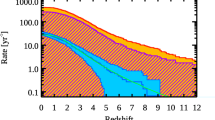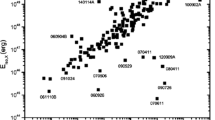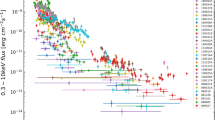Abstract
THE Burst and Transient Source Experiment (BATSE) on the Compton Gamma-Ray Observatory has shown that, although γ-ray bursts are distributed isotropically on the sky, there is an apparent dearth of weak events compared to those expected from a homogeneous distribution of sources1,2. This suggests that the bursts originate either in an extended galactic halo3 (that is, locally) or at cosmological distances4,5. The intensity distribution of the bursts can be used to constrain their source properties and spatial distribution, and here we address this question by considering the BATSE data with those from the Pioneer Venus Orbiter, correcting for the different reponse of the two instruments. We show that the composite intensity distribution can after all be fitted by a simple, homogeneous model of γ-ray burst sources with identical intrinsic luminosities where the faintest BATSE events are at a redshift of z∼0.80±0.05. We obtain an upper limit of about −18 on the absolute magnitude of the host galaxies by assigning model-derived distances to the brightest extragalactic objects found15 within the error boxes of eight well localized γ-ray bursts. All but the faintest active galaxies are excluded as the source of the bursts. The bursts may instead be associated with normal galaxies, but only if the host-galaxy magnitudes are close to our upper limit.
Similar content being viewed by others
References
Meegan, C. A. et al. Nature 335, 143–145 (1992).
Meegan, C. A. et al. in Gamma-ray Bursts, Proc. of the Huntsville Conference (eds Paciesas, W. & Fishman, G.) 61–69 (Am. Inst. Phys. publ. No. 265, New York, 1992).
Mao, S. & Paczynski, B. Astrophys. J. 389, L13–L16 (1992).
Paczynski, B. Astrophys. J. 308, L43–L46 (1986).
Paczynski, B. in Gamma-ray Bursts, Proc. of the Huntsville Conference, (eds Paciesas, W & Fishman, G.) 144–148 (Am. Inst. Phys, publ. No. 265, New York, 1992).
Piran, T. Astrophys. J. 389, L45–L48 (1992).
Wickramasinghe, W. et al. Astrophys. J. (submitted).
Dermer, C. Phys. Rev. Lett. 68, 1799–1802 (1992).
Fenimore, E. E. et al. Nature 357, 140–142 (1992).
Mao, S. & Paczynski, B. Astrophys. J. 388, L45–L48 (1992).
Fenimore, E. E. et al. in Proc. of the St. Louis Compton Gamma-ray Obs. Conference (eds Friedlander, M., Gehrels, N. & Macomb, D.) 744–748 (Am. Inst. Phys. Publ, No. 280, New York, 1993).
Teegarden, B. et al. in Proc. of the St. Louis Compton Gamma-ray Obs. Conference (eds Friedlander, M., Gehrels, N. & Macomb, D.) 860–863 (Am. Inst. Phys. Publ. No. 280, New York, 1993).
Fenimore, E. E. et al. in Gamma-ray Bursts, Proc. of the Huntsville Conference (eds Paciesas, W. & Fishman, G.) 108–112 (Am. Inst. Phys. Publ. No. 265, New York, 1992).
Lampton, M., Margon, B. & Bowyer, S. Astrophys. J. 208, 177–190 (1976).
Schaefer, B. E. in Gamma-ray Bursts: Observations, Analyses, and Theories (eds Ho, C., Epstein, R. & Fenimore, E. E.) 107–111 (Cambridge Univ. Press, 1992).
Pedersen, H. et al. Astrophys. J. 270, L43–L47 (1983).
Osterbrock, D. E. Rep. Prog. Phys. 54, 579–633 (1991).
Schmidt, M. J., Higdon, J. & Heuter, G. Astrophys. J. 329, L85–L88 (1988).
Boyle, B. J., Shanks, T. & Peterson, B. A. Mon. Not. R. astr. Soc. 235, 935–948 (1988).
Hawkins, M. R. S. & Veron, P. Mon. Not. R. astr. Soc. 260, 202–208 (1983).
Epstein, R. I., Fenimore, E. E., Leonard, P. J. T. & Link, B. in Proc. of the Texas/PASCOS Conf. (eds Akenlof, C. W. & Srednicki, M. A.) 685, 565 (New York Acad. Sci.).
Meszaros, P. & Rees, M. J. Astrophys. J. 397, 570–575 (1992).
Author information
Authors and Affiliations
Rights and permissions
About this article
Cite this article
Fenimore, E., Epstein, R., Ho, C. et al. The intrinsic luminosity of γ-ray bursts and their host galaxies. Nature 366, 40–42 (1993). https://doi.org/10.1038/366040a0
Received:
Accepted:
Issue Date:
DOI: https://doi.org/10.1038/366040a0
- Springer Nature Limited





